New Jersey

America the Story of Us: Declaration of Independence
The Declaration of Independence marks the first such document declaring the equality of men. Own America. One of the most important events in all world history (not to mention American history) was the American Revolutionary War. Through the battles that were to take place between Great Britain and its American Colonies, the face of the world would be changed forever with the birth of a new nation. The Revolutionary War and the significant events that transpired immediately before and after are essential to understand. New Jersey played a large roll in the Declaration of Independence of our country.
Timeline of New Jersey: 1500’s – 1600’s
 (1524) Giovanni de Verrazano explored coastline
(1524) Giovanni de Verrazano explored coastline
(1609) Henry Hudson sailed into Newark Bay, claimed land for Dutch, named it New Netherlands- (1638) Swedish colony established along lower Delaware River
- (1660) Dutch settled Bergen, first permanent town
- (1664) British took control of New Jersey from Dutch; renamed it New Jersey
- (1676) New Jersey colony divided into East and West
1700’s
- (1702) East and West Jersey became Crown Colony under supervision of governor of New York
 (1736) New Jersey formed own government
(1736) New Jersey formed own government- (1774) Tea burning at Greenwich in protest of taxes
- (1776 – 1783) Over 100 battles took place in New Jersey during Revolutionary War
- (1776) New Jersey adopted first state constitution; George Washington crossed Delaware River from Pennsylvania in surprise attack on British; Washington defeated British at Battle of Trenton
- (1777) Washington headquartered at Morriston
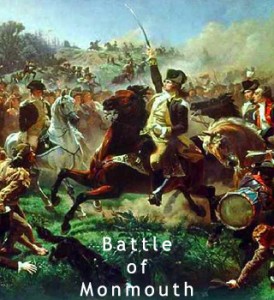 (1778) Washington victorious at Battle of Monmouth
(1778) Washington victorious at Battle of Monmouth- (1783) Princeton served as U.S. capital
- (1784) Trenton served as U.S. capital
- (1787) New Jersey became third U.S. state
- (1790) Trenton declared state capital; New Jersey first state to sign Bill of Rights
- (1791) Alexander Hamilton built country’s first planned industrial city in Paterson
1800’s
- (1804) Alexander Hamilton and Aaron Burr dueled in Weehawken; new legislation enacted – any person born after July 4, 1804, considered free
- (1824) First ferry service in U.S. opened between Hoboken and Manhattan
- (1835) Colt firearms begins production in Paterson
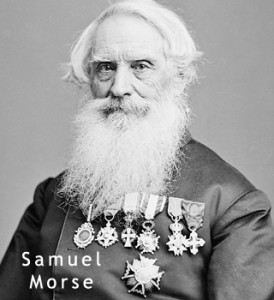 (1838) Samuel Morse demonstrated telegraph
(1838) Samuel Morse demonstrated telegraph- (1844) New Jersey adopted second state constitution
- (1846) First baseball game held at Hoboken
- (1858) Dinosaur fossil found at Haddonfield
- (1860) New Jersey granted electoral votes to Stephan Douglas, running against Abraham Lincoln
- (1861 – 1865) 88,000 New Jerseyites fought in Civil War; state became component of Underground Railroad
- (1864) New Jersey granted electoral votes to George McClellan, running against Abraham Lincoln; only free state that rejected Lincoln twice
- (1869) First intercollegiate football game played at New Brunswick
- (1879) Thomas Edison invented incandascent lamp
- (1882) First amusement pier over ocean built in Atlantic City
- (1883) Roselle is the first United States town to be lighted by electricity
- (1884) Grover Cleveland, New Jersey native, elected U. S. President
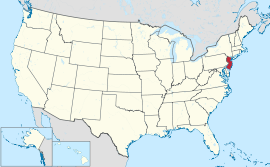 New Jersey (
New Jersey (![]() i/nuː ˈdʒɜrzi/) is a state in the Northeastern and Middle Atlantic regions of the United States. It is bordered on the north and east by the U.S. state of New York, on the southeast and south by the Atlantic Ocean, on the west by Pennsylvania, and on the southwest by Delaware. New Jersey is the 4th least extensive, but the 11th most populous and the most densely populated of the 50 United States. New Jersey lies mostly within the sprawling metropolitan areas of New York City and Philadelphia. It is also the third wealthiest by 2009–2010 median household income.
i/nuː ˈdʒɜrzi/) is a state in the Northeastern and Middle Atlantic regions of the United States. It is bordered on the north and east by the U.S. state of New York, on the southeast and south by the Atlantic Ocean, on the west by Pennsylvania, and on the southwest by Delaware. New Jersey is the 4th least extensive, but the 11th most populous and the most densely populated of the 50 United States. New Jersey lies mostly within the sprawling metropolitan areas of New York City and Philadelphia. It is also the third wealthiest by 2009–2010 median household income.
The area was inhabited by Native Americans for more than 2,800 years, with historical tribes such as the Lenape along the coast. In the early 17th century, the Dutch and the Swedes made the first European settlements. The British later seized control of the region, naming it the Province of New Jersey. It was granted as a colony to Sir George Carteret and John Berkeley, 1st Baron Berkeley of Stratton. At this time, it was named after the largest of the British Channel Islands,Jersey, Carteret’s birthplace. New Jersey was the site of several decisive battles during the American Revolutionary War.
In the 19th century, factories in cities such as Elizabeth, Paterson, and Trentonhelped to drive the Industrial Revolution. New Jersey’s position at the center of the Northeast megalopolis, between Boston and New York City to the northeast, and Philadelphia, Baltimore, and Washington, D.C. to the southwest, fueled its rapid growth through the process of suburbanization in the 1950s and beyond.
History
Around 180 million years ago, during the Jurassic Period, New Jersey bordered North Africa. The pressure of the collision between North America and Africa gave rise to the Appalachian Mountains. Around 18,000 years ago, the Ice Age resulted in glaciers that reached New Jersey. As the glaciers retreated, they left behind Lake Passaic, as well as many rivers, swamps, and gorges.
New Jersey was originally settled by Native Americans, with the Lenni-Lenape being dominant at the time Europeans arrived. The Lenape were loosely organized groups that practiced small-scale agriculture (mainly based on corn) in order to increase their largely mobile hunter-gatherer society in the region surrounding the Delaware River, the lower Hudson River, and western Long Island Sound. The Lenape society was divided into matrilinear clans that were based upon common female ancestors. These clans were organized into three distinct phratries identified by their animal sign: Turtle, Turkey, and Wolf. They first encountered the Dutch in the early 17th century, and their primary relationship with the Europeans was through fur trade.
Colonial era
New Jersey was first claimed by the Dutch. The Dutch colony of New Netherland consisted of parts of modern Middle Atlantic states. Although the European principle of land ownership was not recognized by the Lenape, Dutch West India Company policy required their colonists to purchase land which they settled. The first to do so was Michiel Pauw who established a patronship named Pavonia along the North River which eventually became the Bergen. Peter Minuit‘s purchase of lands along the Delaware River establish the colony of New Sweden. The entire region became a territory of England in 1664, when an English fleet under the command of Colonel Richard Nicolls sailed into what is today New York Harbor and took control of Fort Amsterdam, annexing the entire province.
During the English Civil War the Channel Island of Jersey remained loyal to the Crown and gave sanctuary to the King. It was from the Royal Square in St. Helier that Charles II of England was first proclaimed King in 1649, following the execution of his father, Charles I. The North American lands were divided by Charles II, who gave his brother, the Duke of York (later King James II), the region between New England and Maryland as a proprietary colony (as opposed to a royal colony). James then granted the land between the Hudson River and the Delaware River (the land that would become New Jersey) to two friends who had remained loyal through the English Civil War: Sir George Carteret and Lord Berkeley of Stratton. The area was named the Province of New Jersey.
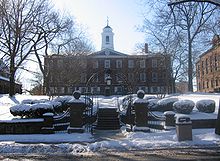 The campuses of Rutgers University (originally chartered as Queen’s College in 1766) include buildings of a variety of architectural styles.
The campuses of Rutgers University (originally chartered as Queen’s College in 1766) include buildings of a variety of architectural styles.
Since the state’s inception, New Jersey has been characterized by ethnic and religious diversity. New England Congregationalists settled alongside Scots Presbyterians and Dutch Reformed migrants. While the majority of residents lived in towns with individual landholdings of 100 acres (40 ha), a few rich proprietors owned vast estates. English Quakers and Anglicans owned large landholdings. Unlike Plymouth Colony, Jamestown and other colonies, New Jersey was populated by a secondary wave of immigrants who came from other colonies instead of those who migrated directly from Europe. New Jersey remained agrarian and rural throughout the colonial era, and commercial farming only developed sporadically. Some townships, such as Burlington on the Delaware River and Perth Amboy, emerged as important ports for shipping to New York and Philadelphia. The colony’s fertile lands and tolerant religious policy drew more settlers, and New Jersey boasted a population of 120,000 by 1775.
Settlement for the first 10 years of English rule was along Hackensack River and Arthur Killand settlers came primarily from New England. Unlike other colonies that were settled by immigrants from Europe, New Jersey was populated by a secondary wave of settlement from communities already established on the North American continent. March 18, 1673, Berkeley sold his half of the colony to Quakers in England, who settled the Delaware Valley region as a Quaker colony. (William Penn acted as trustee for the lands for a time.) New Jersey was governed very briefly as two distinct provinces, East and West Jersey, for 28 years between 1674 and 1702, at times part of the Province of New York orDominion of New England.
In 1702, the two provinces were reunited under a royal, rather than a proprietary, governor. Edward Hyde, Lord Cornbury, became the first governor of the colony as a royal colony. Lord Cornbury was an ineffective and corrupt ruler, taking bribes and speculating on land, so in 1708 he was recalled to England. New Jersey was then ruled by the governors of New York, but this infuriated the settlers of New Jersey, who accused those governors of favoritism to New York. Judge Lewis Morris led the case for a separate governor, and was appointed governor by King George II in 1738.
Revolutionary War era
New Jersey was one of the Thirteen Colonies that revolted against British rule in the American Revolution. The New Jersey Constitution of 1776 was passed July 2, 1776, just two days before the Second Continental Congress declared American Independence from Great Britain. It was an act of the Provincial Congress, which made itself into the state Legislature. To reassure neutrals, it provided that it would become void if New Jersey reached reconciliation with Great Britain.
 George Washington rallying his troops at the Battle of Princeton
George Washington rallying his troops at the Battle of Princeton
New Jersey representatives Richard Stockton, John Witherspoon, Francis Hopkinson, John Hart, and Abraham Clark were among those who signed the United States Declaration of Independence.
During the American Revolutionary War, British and American armies crossed New Jersey numerous times, and several pivotal battles took place in the state. Because of this, New Jersey today is often referred to as “The Crossroads of the Revolution.” The winter quarters of the revolutionary army were established there twice by General George Washington in Morristown, which was called the military capital of the revolution.
On December 25, 1776, the Continental Army under George Washington crossed the Delaware River. After the crossing, he surprised and defeated the unprepared Hessian troops in the Battle of Trenton. Slightly more than a week after victory at Trenton, on January 3, 1777, American forces gained an important victory by stopping General Cornwallis’s charges at the Second Battle of Trenton. By evading Cornwallis’s army, Washington made a surprise attack on Princetonand successfully defeated the British forces there. Emanuel Leutze‘s painting of Washington Crossing the Delaware became an icon of the Revolution.
American forces under Washington met the forces under General Henry Clinton at the Battle of Monmouth in an indecisive engagement in June 1778. Washington attempted to take the British column by surprise; when the British army attempted to flank the Americans, the Americans retreated in disorder. The ranks were later reorganized and withstood the British charges.
In the summer of 1783, the Continental Congress met in Nassau Hall at Princeton University, making Princeton the nation’s capital for four months. It was there that the Continental Congress learned of the signing of the Treaty of Paris (1783), which ended the war.
On December 18, 1787, New Jersey became the third state to ratify the United States Constitution, which was overwhelmingly popular in New Jersey, as it prevented New York and Pennsylvania from charging and keeping tariffs on goods imported from Europe. On November 20, 1789, the state became the first in the newly formed Union to ratify the Bill of Rights.
The 1776 New Jersey State Constitution gave the vote to “all inhabitants” who had a certain level of wealth. This included women and blacks, but not married women, because they could not own property separately from their husbands. Both sides, in several elections, claimed that the other side had had unqualified women vote and mocked them for use of “petticoat electors” (entitled to vote or not); on the other hand, both parties passed Voting Rights Acts. In 1807, the legislature passed a bill interpreting the constitution to mean universal white male suffrage, excluding paupers. (This was less revolutionary than it sounds: the “constitution” was itself only an act of the legislature.)
19th century
On February 15, 1804, New Jersey became the last northern state to abolish new slavery and enacted legislation that slowly phased out existing slavery. This led to a gradual scale-down of the slave population. By the close of the Civil War about a dozen African Americans in New Jersey were still apprenticed freedmen. New Jersey voters initially refused to ratify the constitutional amendments banning slavery and granting rights to the United States’ black population.
In 1844, the second state constitution was ratified and brought into effect. Counties thereby became districts for the State Senate, and some realignment of boundaries (including the creation of Mercer County) immediately followed. This provision was retained in the 1947 Constitution, but was overturned by the Supreme Court of the United States in 1962 by the decision Baker v. Carr. While the Governorship was stronger than under the 1776 constitution, the constitution of 1844 created many offices that were not responsible to him, or to the people, and it gave him a three-year term, but he could not succeed himself.
Unlike the Revolutionary War, no Civil War battles took place within the state. However, throughout the course of the Civil War, over 80,000 from New Jersey enlisted in the Northern army to defeat the Southern Confederacy.
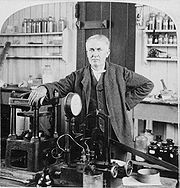 Thomas Edison in his laboratory, West Orange, New Jersey, 1901
Thomas Edison in his laboratory, West Orange, New Jersey, 1901
New Jersey was one of the few Northern states (the others being Delaware and Kentucky) to select a candidate other than Abraham Lincoln twice in national elections, and sided with Stephen Douglas (1860) and George B. McClellan (1864) during their campaigns. McClellan later became governor (1878–81). During the Civil War, the state was led first by Republican Governor Charles Smith Olden, then by Democrat Joel Parker.
In the Industrial Revolution, cities like Paterson grew and prospered. Previously, the economy had been largely agrarian, which was problematically subject to crop failures and poor soil. This caused a shift to a more industrialized economy, one based on manufactured commodities such as textiles and silk. Inventor Thomas Edison also became an important figure of the Industrial Revolution, having been granted 1,093 patents, many of which for inventions he developed while working in New Jersey. Edison’s facilities, first at Menlo Park and then in West Orange, are considered perhaps the first research centers in the U.S. Christie Street in Menlo Park was the first thoroughfare in the world to have electric lighting. Transportation was greatly improved as locomotion and steamboats were introduced to New Jersey.
Iron mining was also a leading industry during the middle to late 19th century. Bog iron pits in the Southern New Jersey Pinelands were among the first sources of iron for the new nation. Mines such as Mt. Hope, Mine Hill and the Rockaway Valley Mines created a thriving industry. Mining generated the impetus for new towns and was one of the driving forces behind the need for the Morris Canal. Zinc mines were also a major industry, especially the Sterling Hill Mine.

